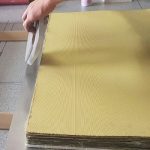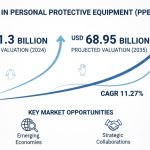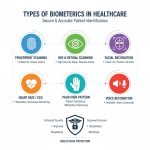Strategic Expansion in the Plastic PPE Market: Industry Leaders Set 2026 Milestones Amidst Competitive Innovations
According to analysts at Vantage Market Research, the Global Plastic in personal protective equipment Market size is worth USD 21.3 Billion in 2024 and is projected to reach USD 68.95 Billion by 2035, growing at a CAGR (Compound Annual Growth Rate) of 11.27% from 2025 to 2035. The key trends include increasing adoption of biodegradable plastics, rising demand for lightweight and durable PPE, advancements in antimicrobial coatings, regulatory compliance focus, growth in healthcare applications, and innovations in sustainable manufacturing processes.
Our comprehensive Plastic in Personal Protective Equipment Market report is ready with the latest trends, growth opportunities, and strategic analysis. View Sample Report PDF.
Key Takeaways from the Report
- Asia Pacific dominated the market industry with 47.5% of market share in 2024. The region market is driven by Rapid industrialization and a growing population in countries like China, India, and South Korea have fueled demand for PPE
- Based on the Product, the Polyethylene (PE) category accounted for significant market share of 22.7% in 2024. The segment is driven by its broad use is due to its versatility, low cost, and adaptability for a wide range of protective applications in industries and healthcare settings
- In 2024, by Application, Hand Protection dominated the market with significant market share of 26.5%. The segment is driven by increasing healthcare needs, industrial expansion, strict safety regulations, and heightened hygiene awareness, especially during the COVID-19 pandemic
- By Distribution Channel, Direct Sales dominated the market with significant market share in 2024
- In 2024, by End User, Healthcare dominated the market with significant market share of 33.6%. These plastics provide durability, chemical resistance, and fluid protection, ensuring the safety of both medical workers and patients
Premium Insights
The plastic in PPE market is witnessing a shift towards lightweight, durable, and cost-effective materials. Innovations in polymer technology are leading to the development of products that offer enhanced protection without compromising comfort. Additionally, the rise in global industrial activities and the ongoing emphasis on worker safety are contributing to the market’s expansion. as previously mentioned, the market was valued at USD 21.3 billion in 2024 and is expected to grow at a CAGR of 11.27%, reaching USD 68.95 billion by 2035. This growth is attributed to the increasing adoption of plastic-based PPE across various sectors.
The market is moderately concentrated, with several key players dominating the landscape. These companies are focusing on product innovation, strategic partnerships, and mergers and acquisitions to strengthen their market position. The industry is characterized by a high degree of competition, technological advancements, and a continuous push towards sustainability.
For Plastic In Personal Protective Equipment Market Research Report and updates detailed: View Full Report Now!
Strategic Expansion in the Plastic PPE Market: Industry Leaders Set 2026 Milestones Amidst Competitive Innovations
- Ansell Limited: Following the acquisition of Kimberly-Clark’s Personal Protective Equipment (PPE) business for USD 640 million in 2024, Ansell aims to integrate the Kimtech and KleenGuard brands into its portfolio. This strategic move is expected to enhance Ansell’s presence in the scientific and industrial markets, with anticipated synergies of USD 10 million by the third-year post-acquisition. The company projects an earnings accretion of 4% from the 2027 financial year.
- Honeywell International Inc.: In November 2024, Honeywell announced the sale of its PPE business to Protective Industrial Products (PIP) for USD 1.325 billion. This divestiture aligns with Honeywell’s strategy to streamline its portfolio and focus on core areas such as automation, aviation, and energy transition. The transaction is expected to be finalized in the first half of 2025.
- 3M Company: In May 2024, 3M invested USD 67 million to expand its safety product manufacturing in Nebraska. This expansion includes new production lines, equipment, and a warehouse, aiming to enhance the company’s capacity to meet the growing demand for personal protective equipment.
- DuPont de Nemours, Inc.: DuPont is focusing on advancing sustainability in PPE through stronger customer collaborations. The company is committed to innovating for a circular economy and continuously improving its operational footprint to support sustainable personal protection solutions.
- Lakeland Industries, Inc.: In September 2025, Lakeland Fire + Safety was awarded a USD 5.6 million contract from the Hong Kong Fire Services Department. This agreement includes advanced decontamination, care services, and maintenance for firefighter protective gear, demonstrating Lakeland’s commitment to enhancing firefighter safety and operational efficiency.
Product Insights
The market is segmented into Gloves, Gowns, Masks, Face Shields, Footwear, and Others. Gloves and masks dominate due to high demand in healthcare and industrial safety. Gowns and face shields are increasingly adopted in medical and chemical sectors. Footwear and specialty PPE cater to niche industries requiring protection against chemicals, heat, or mechanical hazards, driving market diversification.
Application Insights
Applications include Industrial, Healthcare, Construction, Chemical & Pharmaceutical, and Others. Industrial use remains dominant, driven by stringent safety regulations. Healthcare demand is growing due to hygiene and infection control. Construction requires protective gear for physical hazards, while chemical and pharmaceutical industries demand chemical-resistant PPE. Other sectors like food processing contribute to steady adoption.
Distribution Channel Insights
Distribution channels include Online Stores, Retail Stores, and Direct Sales. Online stores are gaining prominence due to convenience and global reach. Retail stores provide visibility and immediate availability, especially in urban markets. Direct sales cater to large industrial clients seeking bulk orders and customized solutions, enhancing efficiency and customer relationships.
End User Insights
End users include Manufacturing, Laboratories, Oil & Gas, Food Processing, and Others. Manufacturing dominates due to high worker exposure to physical hazards. Laboratories and healthcare facilities require specialized PPE for chemical and biological safety. Oil & Gas industries need high-performance gear, while food processing prioritizes hygiene. Other end users represent niche sectors with specific safety requirements.
Regional Insights
North America Plastic In Personal Protective Equipment Market Trends
North America is a leading market for plastic in PPE due to stringent occupational safety regulations and high industrial activity. The U.S. and Canada are key contributors, driven by demand from healthcare, construction, and chemical industries. Technological innovation, government safety mandates, and awareness campaigns are promoting the adoption of advanced plastic PPE. The region also emphasizes sustainability, prompting manufacturers to develop recyclable and eco-friendly PPE solutions, positioning North America as a hub for high-quality, regulated protective equipment.
Europe Plastic In Personal Protective Equipment Market Trends
Europe’s plastic PPE market is expanding steadily due to strong regulatory frameworks, high labor safety standards, and well-established healthcare and industrial sectors. Countries like Germany, France, and the UK lead adoption, focusing on advanced and innovative PPE solutions. The demand is driven by rising industrial automation, construction, and chemical manufacturing activities. Sustainability initiatives and increased awareness of workplace hazards encourage manufacturers to provide eco-friendly and reusable plastic PPE products, supporting market growth across the region.
Asia Pacific Plastic In Personal Protective Equipment Market Trends
The Asia Pacific market is witnessing rapid growth due to industrialization, urbanization, and increasing safety awareness. Countries like China, India, Japan, and South Korea are key contributors, driven by healthcare, manufacturing, and construction sectors. Rising government initiatives for workplace safety, coupled with a growing e-commerce penetration for PPE products, are boosting market adoption. Additionally, cost-effective manufacturing and a large labor force create opportunities for expanding the production and use of plastic-based protective equipment in the region.
Latin America Plastic In Personal Protective Equipment Market Trends
Latin America is experiencing steady growth in the plastic PPE market, driven by rising industrialization and increasing safety regulations. Brazil and Mexico are the leading markets, with demand primarily from healthcare, manufacturing, and construction sectors. Government initiatives and safety compliance programs are promoting PPE adoption. However, market growth is challenged by budget constraints and limited awareness in some areas, prompting manufacturers to offer cost-effective solutions and training programs to increase penetration and adoption of plastic PPE in the region.
Middle East & Africa Plastic In Personal Protective Equipment Market Trends
The Middle East & Africa market is growing steadily due to expanding construction, oil & gas, and industrial activities. Countries like UAE, Saudi Arabia, and South Africa are key markets, driven by government safety mandates and rising awareness of occupational hazards. Investments in infrastructure and industrial safety regulations are promoting PPE adoption. However, limited local manufacturing and dependency on imports remain challenges. Manufacturers are increasingly focusing on customized, durable, and heat-resistant plastic PPE to meet regional environmental and safety requirements.
Key Plastic in Personal Protective Equipment Company Insights
Leading companies in the plastic PPE market include:
- BASF
- SABIC
- Evonik Industries AG
- Sumitomo Chemical Co., Ltd.
- Arkema
- Celanese Corporation
- Eastman Chemical Company
- Chevron Phillips Chemical Company LLC
- Exxon Mobil Corporation
2026 Goals for Leading Companies
- Ansell: Focus on integrating Kimberly-Clark’s PPE business and expanding its product portfolio in the scientific and industrial sectors.
- Honeywell International Inc.: Enhance innovation in PPE design and materials to meet evolving safety standards.
- 3M: Strengthen global distribution networks and invest in sustainable PPE solutions.
- DuPont: Develop advanced materials for high-performance protective clothing and equipment.
- Lakeland Industries: Expand market presence through strategic partnerships and acquisitions.
Recent Developments
- In 2024, Ansell announced the acquisition of Kimberly-Clark’s PPE business for USD 640 million. This strategic move aims to enhance Ansell’s position in the scientific and industrial PPE markets, expanding its product offerings and market reach.
Plastic in Personal Protective Equipment Market Report Scope
The market report provides a comprehensive analysis of the global plastic in PPE market from 2024 to 2035, covering revenue, growth trends, and CAGR. It includes detailed segmentation by product, application, distribution channel, and end user. Regional insights across North America, Europe, Asia Pacific, Latin America, and Middle East & Africa are provided. The report also highlights key players, market dynamics, recent developments, and strategic goals, offering actionable insights for stakeholders and investors.
Market Dynamics
Driver
The primary driver of the plastic PPE market is the growing emphasis on workplace safety across industries. Strict government regulations, rising industrialization, and awareness of occupational hazards are encouraging companies to invest in high-quality protective gear. Additionally, the healthcare sector’s increasing demand for disposable and durable PPE amid infection control concerns further boosts market growth. Innovation in lightweight, durable, and comfortable plastic materials is also enhancing adoption rates globally.
Restraint
A significant restraint for the market is the high cost and environmental concerns associated with plastic PPE. Manufacturing advanced plastic PPE involves expensive raw materials and technology, limiting adoption in price-sensitive regions. Furthermore, single-use plastic PPE contributes to environmental pollution, prompting regulatory scrutiny and restrictions in several countries. These factors, combined with a lack of awareness in certain developing regions, can slow market penetration and hinder widespread adoption.
Opportunity
The market presents a substantial opportunity through innovation in sustainable and recyclable PPE materials. Companies can leverage biodegradable plastics, reusable products, and eco-friendly manufacturing processes to meet growing environmental concerns. Additionally, expanding e-commerce platforms and digital awareness campaigns provide new channels to reach industrial and healthcare customers. Emerging markets in Asia Pacific, Latin America, and Africa also offer untapped growth potential as governments enforce stricter safety regulations and industries modernize.
Challenges
Key challenges include supply chain disruptions, fluctuating raw material prices, and inconsistent safety standards across regions. Manufacturers must maintain production efficiency while ensuring compliance with diverse regulatory requirements. Proper training for correct usage of PPE and overcoming cultural or operational resistance in certain regions also pose hurdles. Addressing these challenges requires investment in robust supply chains, quality assurance, and customer education to ensure consistent adoption and effective market growth.
Global Plastic in Personal Protective Equipment Market Report Segmentation
- By Product: Polyethylene (PE), Polypropylene (PP), Polyurethane (PU), Polyvinyl Chloride (PVC), Polyethylene Terephthalate (PET), Polystyrene (PS), Acrylonitrile Butadiene Styrene (ABS), Polycarbonate (PC), Polyamide (PA), Polysulfone (PSU), Polyphenylsulfone (PPSU), Acrylic, Polyester, Others
- By Application: Head, Eye & Face Protection, Hearing Protection, Protective Clothing, Respiratory Protection, Protective Footwear, Fall Protection, Hand Protection, Others
- By Distribution Channel: Direct Sales, Distribution Partners, E-commerce, Retail Stores, Medical Supply Companies,
- By End User: Healthcare, Construction, Manufacturing, Mining, Oil and Gas, Emergency Services, Military
- By Region: North America, Europe, Asia Pacific, Latin America, Middle East & Africa
Frequently Asked Questions
- What is the projected growth rate of the plastic in PPE market?
The market is expected to grow at a CAGR of 11.27% from 2025 to 2035.
- Which region holds the largest market share?
North America leads the market due to stringent safety regulations and a strong industrial base.
- What are the key materials used in plastic PPE?
Common materials include polyethylene, polypropylene, polyvinyl chloride, and polycarbonate.
- Who are the leading companies in the market?
Key players include Ansell, Honeywell International Inc., 3M, DuPont, and Lakeland Industries.
- What are the challenges faced by the industry?
Challenges include high manufacturing costs, environmental concerns, and supply chain disruptions.
![[Market Research Reports] – Research Google News Blog | VMR.Biz](https://www.vmr.biz/wp-content/uploads/2022/12/logo-removebg-preview.png)











